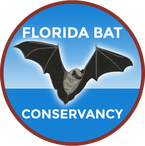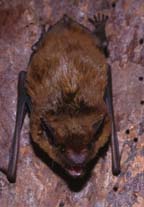Big brown bat
Description: The fur is long, silky and varies in color from Chocolate-brown to reddish- or golden-brown. The ears and wing membranes are dark brown to nearly black. The big brown bat is similar in appearance to the evening bat, but is larger in size.
Wingspan: 13-14 inches
Body length: 2.1-3.2 inches
Weight: 0.4-0.8 ounces
Florida roosting preferences: Colonial. Dead tree cavities provide the normal roosting habitat for this bat, but one colony was found roosting in the base of a royal palm leaf stem in south Florida. They also move into buildings, bridges and bat houses.
Food preferences: Insectivorous. They feed on beetles, planthoppers, true bugs, flies, mosquitoes, flying termites, flying ants and a number of other insects.
Reproduction: Females usually give birth to two pups in may or June.
Florida status: Uncommon in north and central Florida. Rare in south Florida.
Florida range: Found throughout the state except the Florida Keys.
Copyright Florida Bat Conservancy 2005
Wingspan: 13-14 inches
Body length: 2.1-3.2 inches
Weight: 0.4-0.8 ounces
Florida roosting preferences: Colonial. Dead tree cavities provide the normal roosting habitat for this bat, but one colony was found roosting in the base of a royal palm leaf stem in south Florida. They also move into buildings, bridges and bat houses.
Food preferences: Insectivorous. They feed on beetles, planthoppers, true bugs, flies, mosquitoes, flying termites, flying ants and a number of other insects.
Reproduction: Females usually give birth to two pups in may or June.
Florida status: Uncommon in north and central Florida. Rare in south Florida.
Florida range: Found throughout the state except the Florida Keys.
Copyright Florida Bat Conservancy 2005
© Copyright 2020 Florida Bat Conservancy

